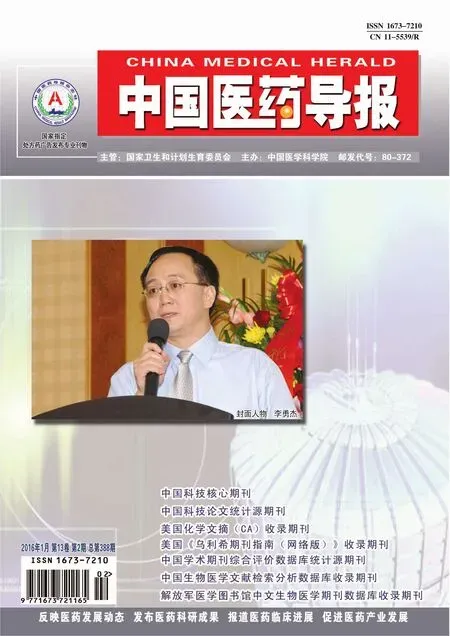顱內微創穿刺血腫引流術治療老年高血壓腦出血的效果及對NT-proBNP、HMGB-1 和GM-CSF水平的影響
陳 果 董 偉重慶市第五人民醫院神經外科,重慶 400062
顱內微創穿刺血腫引流術治療老年高血壓腦出血的效果及對NT-proBNP、HMGB-1 和GM-CSF水平的影響
陳果董偉
重慶市第五人民醫院神經外科,重慶400062
目的 探討顱內微創穿刺血腫引流術治療老年高血壓腦出血的效果及其對N末端腦鈉肽前體 (NT-proBNP)、高遷移率族蛋白1(HMGB-1)和血漿粒細胞巨噬細胞集落刺激因子(GM-CSF)水平的影響。方法 選取2009年2月~2015年6月重慶市第五人民醫院神經外科診治的82例急性老年高血壓腦出血患者為研究對象,根據手術方式的不同將患者分為顱內微創穿刺血腫引流術組(微創組)和小骨窗血腫清除術/去骨瓣減壓血腫清除術(常規組),每組各41例,分別比較兩組患者的臨床療效及其NT-proBNP、HMGB-1和GM-CSF的變化水平。結果 術后7 d和14 d,兩組出血量均較術前顯著下降(P<0.05),但兩組組間比較差異無統計學意義(P>0.05)。術后14 d常規組格拉斯哥昏迷評分(GCS)和Barthel指數均較術前明顯升高,而美國國立衛生研究院卒中量表(NIHSS)評分顯著降低(P<0.05);微創組上述三項指標術后7 d即出現明顯改善(P<0.05),且術后14 d GCS評分和Barthel指數明顯高于常規組,而NIHSS評分則顯著低于常規組 (P<0.05)。術后微創組治療有效率為75.61%(31/41),顯著高于常規組的41.46%(17/41)(P<0.05),但兩組并發癥發生率比較差異無統計學意義(P>0.05)。術后7 d和14 d,微創組NT-proBNP、HMGB-1和GM-CSF水平均較術前顯著下降(P<0.05);常規組僅在術后14 d上述指標水平才出現明顯降低(P<0.05);而且,微創組患者NT-proBNP、HMGB-1和GM-CSF水平均顯著低于常規組(P<0.05)。結論 顱內微創穿刺血腫引流術可以有效清除老年高血壓腦出血患者的出血病灶,調節腦內NT-proBNP、HMGB-1和GM-CSF水平,促進神經功能的恢復和生活質量的提高。
顱內微創穿刺血腫引流術;高血壓腦出血;N末端腦鈉肽前體;高遷移率族蛋白1;粒細胞巨噬細胞集落刺激因子
高血壓腦出血是神經系統常見的老年性疾病,占全部腦卒中的20%~30%,具有較高的病死率和致殘率,嚴重威脅患者的生命健康[1]。傳統的內科保守治療和開顱清除血腫的外科治療方式雖然能在一定程度上降低患者的病死率,但疾病預后并不理想,絕大多數患者治療后無法正常自理生活或神經功能受到嚴重損害[2-3]。顱內微創穿刺血腫引流術是國內外較為認可的治療高血壓腦出血的微創手術方法,但該術式對老年患者是否也有較好的療效尚未明確[4]。據此,本研究以82例老年高血壓腦出血患者為研究對象,探討顱內微創穿刺血腫引流術的治療效果及其對N末端腦鈉肽前體(NT-proBNP)、高遷移率族蛋白1(HMGB-1)和血漿粒細胞巨噬細胞集落刺激因子(GM-CSF)等潛在腦出血標志物水平的影響。現總結報道如下:
1 資料與方法
1.1一般資料
選取2009年2月~2015年6月重慶市第五人民醫院神經外科診治的82例急性老年高血壓腦出血患者為研究對象,其中男49例,女33例,年齡60~79歲,平均(63.12±5.85)歲。所有患者均經頭顱CT或核共振成像(MRI)影像學證實,診斷標準嚴格依據全國第4屆腦血管病學術會議制訂的高血壓腦出血標準[5]執行。血腫部分:基底節52例,丘腦16例,腦葉14例;格拉斯哥昏迷評分(GCS):>12分 20例,8~12分45例,<8分17例;出血量(以多田氏公式計算):30~<50 mL 44例,50~<70 mL 29例,≥70 mL 9例;納入標準:①首次發病,入院時間24 h以內;②未罹患有血管畸形、出血破入腦室、蛛網膜下腔出血、凝血功能障礙和其他嚴重慢性疾病等;③心、肺、肝、腎功能檢查未發現顯著異常;④發病前無明顯的神經認知功能障礙;⑤無明顯手術禁忌,愿意參與本研究,且依從性良好。本研究方案通過醫院倫理委員會批準,所有患者及家屬均知情本研究且簽署知情同意書。根據手術方式的不同,將患者分為顱內微創穿刺血腫引流術組(微創組)和小骨窗血腫清除術/去骨瓣減壓血腫清除術 (常規組),每組各41例。兩組患者年齡、性別、入院時間、GCS評分、出血部位、出血量等一般資料比較,差異均無統計學意義(P>0.05),具有可比性。見表1。

表1 兩組一般資料比較
1.2手術方法
所有患者入院后給予常規脫水降低顱內壓、控制血壓、營養神經、控制感染、維持水電解質平衡和防治上消化道出血等對癥處理治療。其中,微創組患者予以剃光頭發,常規消毒,局部麻醉,采用開顱電鉆鉆孔,在電鉆的驅動下將適當的穿刺針長度的YL-1型一次性顱內血腫碎吸針垂直插入,穿過顱骨和硬腦膜,當穿刺針有明顯下降感時卸下電鉆和鉆頭,取下針芯,改用鈍圓頭針芯邊抽邊轉動針頭,充分抽吸瘀血并慢慢伸入血腫的中心位置,退出針芯,可見陳舊性血液流出,蓋上螺帽,接上引流管,用注射器輕柔地抽出顱內液化部分的血腫,插入針型血腫粉碎器,利用生理鹽水和肝素反復沖洗至流出液變清,加入尿激酶,夾閉引流管4~6 h后開放引流,復查頭顱CT或MRI,待血腫基本消失后拔除穿刺針。常規組患者則在全麻插管下采用去骨瓣減壓或小骨窗血腫清除術對血腫進行清除,其余治療方式與微創組保持一致。
1.3觀察指標及檢測方法
1.3.1臨床療效評估①分別于術前、術后7 d和14 d行頭顱CT或MRI檢查患者,依據多田公式計算血腫大小。②應用GCS評分檢測患者的臨床狀態、并發癥發生和術后再出血情況。③利用格拉斯哥結局量表(GOS)評價患者的預后情況:恢復良好:能獨立生活、工作,但仍有缺陷;輕度殘疾:有思維、言語障礙等,殘疾,但尚能獨立生活、工作;重度殘疾:有意識,殘疾,日常生活需要照料;植物生存或死亡:僅有最小反應,如隨著睡眠/清醒周期,眼睛能睜開。治療有效=恢復良好+輕度殘疾。④采用Barthel指數測量患者術后日常生活能力。⑤采用美國國立衛生研究院卒中量表(national institute of health stroke scale,NIHSS)評價患者神經功能的損傷程度。
1.3.2血漿NT-p roBNP、HMGB-1和GM-CSF的檢測分別于術前、術后7 d和14 d三個時間點采集所有患者的清晨空腹靜脈血液,利用免疫層析法測定NT-proBNP的水平,試劑盒購于武漢明德生物科技有限公司;采用酶聯免疫吸附測定(ELISA)法測定HMGB-1 和GM-CSF的變化水平,試劑盒分別購自于廈門慧嘉生物科技有限公司和美國Invitrogen公司。
1.4統計學方法
所有數據均采用SPSS 18.0軟件予以整理和分析。其中,計量資料以均數±標準差(±s)表示,兩組間比較采用獨立樣本Student-t檢驗,治療前后比較應用配對Student-t檢驗;多個時間點的比較采用重復測量的方差分析,兩組間比較利用LSD-t檢驗;計數資料以構成比或率比較,兩組間比較采用χ2檢驗或Fisher確切概率法。以P<0.05為差異有統計學意義。
2 結果
2.1兩組臨床療效比較
術后7 d和14 d,兩組出血量均較術前顯著下降(P<0.05),但兩組組間比較差異無統計學意義(P>0.05)。術后14 d常規組GCS評分和Barthel指數均較術前明顯升高,而NIHSS評分顯著降低(P<0.05);微創組上述三項指標術后7 d即出現明顯改善(P<0.05),且術后14 d微創組GCS評分和Barthel指數明顯高于常規組,而NIHSS評分則顯著低于常規組(P<0.05)。見表2。
表2 兩組臨床療效比較(±s)

表2 兩組臨床療效比較(±s)
注:與本組術前比較,*P<0.05;與常規組比較,#P<0.05;GCS:格拉斯哥昏迷評分;NIHSS:美國國立衛生研究院卒中量表
組別 出血量(mL)GCS評分(分)NIHSS評分(分)Barthel指數(分)微創組(n=41)術前術后7 d術后14 d常規組(n=41)術前術后7 d術后14 d F值P值52.94±10.58 5.59±1.45*1.42±0.63*8.38±1.48 10.52±1.65*12.89±1.80*#12.58±3.76 8.49±2.64*4.11±1.40*#34.89±5.68 46.18±6.37*60.74±8.19*#53.21±11.61 7.98±1.96*2.15±0.89*0.753 <0.01 8.49±1.51 9.22±1.76 10.84±1.81*12.520 <0.01 12.74±3.10 10.28±2.59 6.50±1.24*6.304 <0.01 35.01±5.43 38.28±5.62 45.93±6.90*9.854 <0.01
2.2兩組預后評價比較
手術結束后,微創組治療有效率為75.61%(31/41),顯著高于常規組的41.46%(17/41),差異有統計學意義(P<0.05)。見表3。

表3 兩組預后評價比較(例)
2.3兩組并發癥發生情況比較
微創組并發癥發生率雖略低于常規組,但兩組組間比較差異無統計學意義(P>0.05)。見表4。

表4 兩組并發癥發生情況比較(例)
2.4兩組血漿NT-proBNP、HMGB-1和GM-CSF水平比較
術后7 d和14 d,微創組NT-proBNP、HMGB-1和GM-CSF水平均較術前顯著下降(P<0.05);常規組僅在術后14 d上述指標水平才出現明顯降低(P<0.05);而且,微創組患者NT-proBNP、HMGB-1和GM-CSF水平均顯著低于常規組(P<0.05)。見表5。
表5 兩組血漿NT-proBNP、HMGB-1和GM-CSF平比較(±s)

表5 兩組血漿NT-proBNP、HMGB-1和GM-CSF平比較(±s)
注:與本組術前比較,*P<0.05;與常規組比較,#P<0.05;NT-proBNP:N末端腦鈉肽前體;HMGB-1:高遷移率族蛋白1;GM-CSF:血漿粒細胞巨噬細胞集落刺激因子
組別 NT-proBNP (pg/mL)HMGB-1 (ng/mL)GM-CSF (pg/mL)微創組(n=41)術前術后7 d術后14 d常規組(n=41)術前術后7 d術后14 d F值P值321.52±34.05 240.58±21.68*166.25±18.23*#21.85±3.97 10.57±1.89*6.29±1.12*#6.94±1.87 2.58±1.02*1.49±0.45*#319.82±31.96 270.58±28.12 205.75±19.07*20.753 <0.01 21.67±3.65 19.28±3.05 14.68±2.84*14.484 <0.01 7.16±1.95 5.28±1.76 4.11±1.59*5.591 <0.05
3 討論
手術治療是高血壓腦出血患者的首選治療方法,尤其是以微創鉆孔引流為代表的微創外科手術方式,具有低侵襲性、高清除率和術后康復快等優勢,正逐步受到認可,操作技術也日臻完善[6-8]。傳統的開顱腦內血腫清除術雖然可以較為徹底地清除血腫,降低顱內高壓,緩解病情,但對周圍正常腦組織的損害仍較大,多數患者預后生存質量并不佳[9-10]。加之,老年高血壓腦出血患者相比其他年齡段患者而言具有一定的特殊性,其體質和免疫力較低下,多器官功能衰退導致病情進展的不確定性和反復性更大,因此,手術方式的選擇被認為是影響老年高血壓腦出血患者預后的重要因素[11-13]。微創顱內血腫清除術在局麻的條件下定向穿刺,可以有效避免顱內正常腦組織再損傷和出血,也能夠有效遏制感染的發生[14-16]。本研究采用顱內微創穿刺血腫引流術進行腦內的血腫清除,結果發現,微創組老年患者術后出血量明顯少于常規組,而且GCS評分和NIHSS評分恢復速度也明顯優于常規組,表明微創穿刺血腫引流術可顯著減輕患者術后的臨床癥狀,改善神經功能,促進疾病的康復。而且,微創組患者術后14 d的Barthel指數也顯著高于常規組,由于本研究的觀測隨訪時間偏短,因此在術后14 d的Barthel指數檢測值相對較低,但該結果仍充分提示,微創穿刺血腫引流術能夠減少患者致殘率,提高術后生活自理的能力。GOS量表檢測顯示,微創組恢復良好+輕度殘疾的患者數量明顯高于常規組,說明微創手術不僅臨床療效較佳,對改善老年高血壓腦出血的預后也具有積極作用。
NT-proBNP被認為是與蛛網膜下腔出血、高血壓腦出血和心源性腦栓塞等多種腦血管事件密切相關的分子[17-18]。本研究結果顯示,治療后兩組患者的NT-proBNP水平均明顯降低,而且微創組術后14 d NT-proBNP水平顯著低于常規組,表明NT-proBNP含量的增加可在一定程度上反映顱內缺血缺氧性損傷的嚴重程度,NT-proBNP水平越高,患者的預后和療效也相對越差。HMGB-1和GM-CSF均是反映顱內免疫-炎性反應水平的關鍵指標,對指示患者體內炎癥蛋白和相關因子的水平具有重要的意義[19-20]。本研究結果顯示,術后兩組患者HMGB-1和GM-CSF的水平均明顯下降,而微創組患者術后7 d即顯著改善,并且在術后14 d時較常規組更低,提示患者體內的免疫-炎癥級聯反應水平得到明顯抑制,這一方面表明微創手術對控制和降低感染風險有積極作用,另一方面也說明臨床上可以借助檢測特異性炎癥因子的水平判定疾病的療效或預后。
[1]Mirsen T.Acute treatment of hypertensive intracerebral hemorrhage[J].Curr Treat Options Neurol,2010,12(6):504-517.
[2]Antihypertensive Treatment of Acute Cerebral Hemorrhage (ATACH)investigators.Antihypertensive treatment of acute cerebral hemorrhage[J].Crit Care Med,2010,38(2):637-648.
[3]Qureshi AI,Palesch YY.Antihypertensive treatment of acute cerebral hemorrhage(ATACH)Ⅱ:design,methods,and rationale[J].Neurocrit Care,2011,15(3):559-576.
[4]Keep RF,Hua Y,Xi G.Intracerebral haemorrhage:mechanisms of injury and therapeutic targets[J].Lancet Neurol,2012,11(8):720-731.
[5]全國第四屆腦血管病學術會議.各類腦血管疾病診斷要點及臨床功能缺損程度評分標準(1995)[J].中華神經科雜志,1996,29(6):379-383.
[6]Elliott J,Smith M.The acute management of intracerebral hemorrhage:a clinical review[J].Anesth Analg,2010,110 (5):1419-1427.
[7]Mould WA,Carhuapoma JR,Muschelli J,et al.Minimally invasive surgery plus recombinant tissue-type plasminogen activator for intracerebral hemorrhage evacuation decreases perihematomal edema[J].Stroke,2013,44(3):627-634.
[8]Mazya M,Egido JA,Ford GA,et al.Predicting the risk of symptomatic intracerebral hemorrhage in ischemic stroke treated with intravenous alteplase Safe Implementation of Treatments in Stroke(SITS)symptomatic intracerebral hemorrhage risk score[J].Stroke,2012,43(6):1524-1531.
[9]Adeoye O,Broderick JP.Advances in the management of intracerebral hemorrhage[J].NatRev Neurol,2010,6(11):593-601.
[10]Steiner T,Juvela S,Unterberg A,et al.European Stroke Organization guidelines for the management of intracranial aneurysms and subarachnoid haemorrhage[J].Cerebrovasc Dis,2013,35(2):93-112.
[11]Raposo N,Viguier A,Cuvinciuc V,et al.Cortical subarachnoid haemorrhage in the elderly:a recurrent event probably related to cerebral amyloid angiopathy[J].Eur JNeurol,2011,18(4):597-603.
[12]Skolarus LE,Morgenstern LB,Zahuranec DB,et al.Acute care and long-term mortality among elderly patients with intracerebral hemorrhage who undergo chronic life-sustaining procedures[J].JStroke Cerebrovasc Dis,2013,22 (1):15-21.
[13]Jüttler,E,Unterberg A,Woitzik J,et al.Hemicraniectomy in older patients with extensive middle-cerebral-artery stroke[J].New Eng JMed,2014,370(12):1091-1100.
[14]Pearce LA,McClure LA,Anderson DC,et al.Effects of long-term blood pressure lowering and dual antiplatelet treatment on cognitive function in patients with recent lacunar stroke:a secondary analysis from the SPS3 randomised trial[J].LancetNeurol,2014,13(12):1177-1185.
[15]Steiner T,Al-Shahi Salman R,Beer R,et al.European Stroke Organisation(ESO)guidelines for the management of spontaneous intracerebral hemorrhage[J].Int JStroke,2014,9(7):840-855.
[16]van Asch CJ,Luitse MJ,Rinkel GJ,et al.Incidence,case fatality,and functional outcome of intracerebral haemorrhage over time,according to age,sex,and ethnic origin:a systematic review andmeta-analysis[J].Lancet Neurol,2010,9(2):167-176.
[17]Chang L,Yan H,Li H,et al.N-terminal probrain natriuretic peptide levels as a predictor of functional outcomes in patients with ischemic stroke[J].Neuro Report,2014,25(13):985-990.
[18]Chaitanya M,Hassan A,Arihiro S,et al.Obesity and natriuretic peptides,BNPand NT-proBNP:Mechanisms and diagnostic implications for heart failure[J].Int J Cardiol,2014,176(3):611-617.
[19]Laird MD,Shields JS,Sukumari-Ramesh S,et al.High mobility group box protein-1 promotes cerebral edema after traumatic brain injury via activation of toll-like receptor 4[J].Glia,2014,62(1):26-38.
[20]Kallmünzer B,TauchiM,Schlachetzki JC,et al.Granulocyte colony-stimulating factor does not promote neurogenesis after experimental intracerebral haemorrhage[J]. Int JStroke,2014,9(6):783-788.
Clinical effect of minimally invasive hematoma drainage in the treatment of elderly patients with hypertensive cerebral hemorrhage and its effect on the levels of NT-proBNP,HMGB-1 and GM-CSF
CHEN Guo DONGWei
Department of Neurosurgery,the Fifth People's Hospital of Chongqing,Chongqing400062,China
Objective To investigate the clinical effect of minimally invasive hematoma drainage in the treatment of elderly patients with hypertension cerebral hemorrhage and its effect on the levels of N-terminal pro-B-type natriuretic peptide(NT-proBNP),highmobility group box-1 protein(HMGB-1)and granulocyte-macrophage colony-stimulating factor(GM-CSF).Methods Eighty two cases of elderly patients with acute hypertensive cerebral hemorrhage treated in Department of Neurosurgery of the Fifth People's Hospital of Chongqing from February 2009 to June 2015 were selected as research objects,and they were divided into minimally invasive intracranial hematoma puncture drainage surgery group(minimally invasive group)and small bone window hematoma/craniotomy hematoma surgery group(conventional group)according to different surgical procedures,each group had 41 cases.The clinical efficacy and the levels of NT-proBNP,HMGB-1 and GM-CSF were compared respectively between two groups.Results After operation for 7 days and 14 days,the bleeding volume of the two groups were significantly decreased compared with be-fore operation(P<0.05),but there were no significant differences between the two groups(P>0.05).After operation for 14 days,the Glasgow coma scale(GCS)and Barthel index in the conventional group were significantly increased compared with before operation,whereas the national institute of health stroke scale(NIHSS)was markedly decreased (P<0.05);the three indexes above in the minimally invasive group were significantly improved after operation for 7 days(P<0.05,and the GCS score and Barthel index at 14 days after operation of minimally invasive group were significantly higher than those of conventional group,while the NIHSS score was significantly lower than that of the conventional group(P<0.05).The effective rate of minimally invasive group was 75.61%(31/41),which was significantly higher than that of the conventional group[41.46%(17/41)](P<0.05),but there was no statistically significant difference of the incidence of complications between the two groups(P>0.05).After operation for 7 days and 14 days,the levels of NT-proBNP,HMGB-1 and GM-CSFwere significantly decreased compared with those before operation(P<0.05);however,the levels of these indicators above were significantly decreased only at 14 days after operation(P<0.05),and the levels of NT-proBNP,HMGB-1 and GM-CSF in the minimally invasive group were significantly lower than those of conventional group(P<0.05).Conclusion Intracranial hematoma drainage can effectively remove the bleeding lesions in elderly patients with hypertensive cerebral hemorrhage,adjust the level of NT-proBNP,HMGB-1 and GM-CSF,and thus promote the recovery of neurological function and improve the quality of life.
Intracranial hematoma drainage;Hypertensive cerebral hemorrhage;N-terminal pro-B-type natriuretic peptide;Highmobility group box-1 protein;Granulocyte-macrophage colony-stimulating factor
R743.2
A
1673-7210(2016)01(b)-0041-05
2015-10-15本文編輯:張瑜杰)
重慶市衛生和計劃生育委員會醫學科研計劃項目(SZX2015187)。
陳果(1973.10-),男,碩士研究生;研究方向:微創血腫清除術治療老年高血壓腦出血的效果。
董偉(1969.3-),男,副主任醫師;研究方向:微創血腫清除術治療老年高血壓腦出血的效果。

